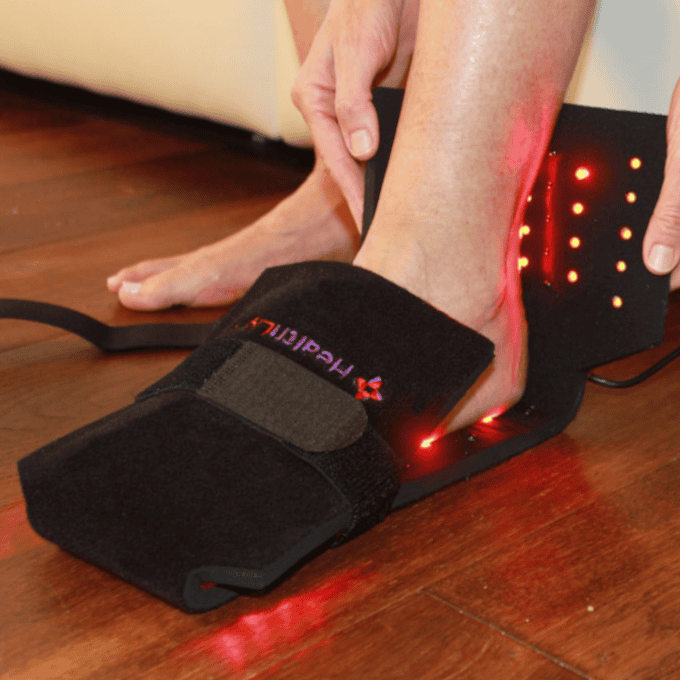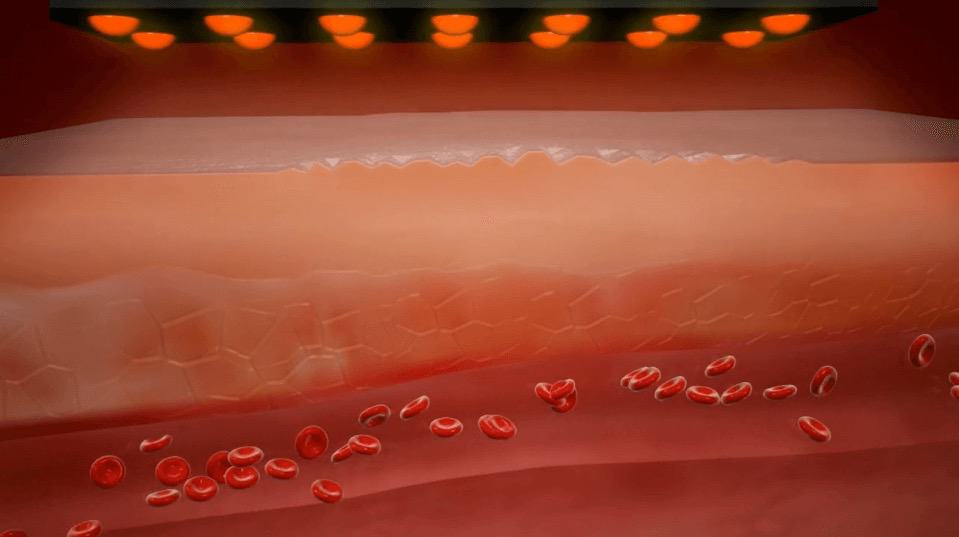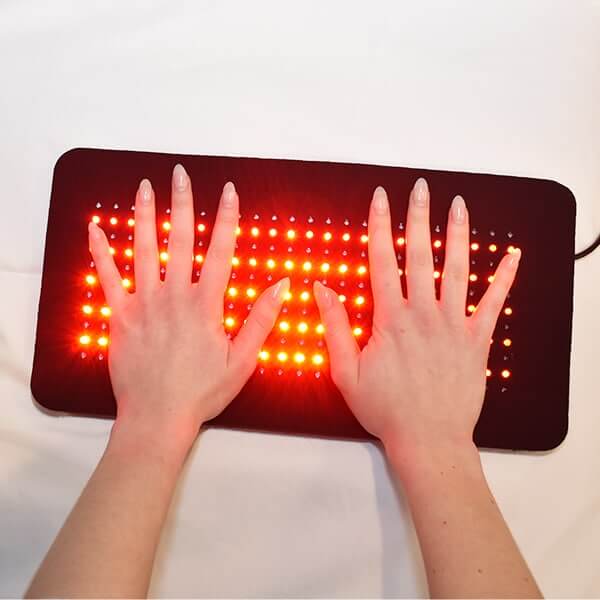Medically reviewed by Karen Wolters, RN.
Perhaps you have seen a Red Light Therapy device at your chiropractic or acupuncture clinic, or at your massage therapist’s office and wondered if this was a brand new type of alternative medical treatment. However, utilizing light to treat various diseases has been going on for thousands of years. In fact, “Use of light as therapeutic approach is one of the oldest known methods to treat different health conditions, and its benefits are known since the ancient Egyptians, Chinese, and Indian populations.”1 So, since light is indeed considered a viable healing modality, which colors or wavelengths of light are most effective for which physical conditions?

The HealthLight Foot & Ankle Pad
Drug-Free Relief Starts Here.
Feel the difference with clinical-strength red light therapy - right where you need it most.
Comparing Red, Infrared, and Blue Light
Researchers have come to realize that light at different wavelengths in the electromagnetic spectrum have different degrees of penetration within the body. Longer wavelengths of light are able to penetrate deeper into tissues. And this difference in penetration results in different biological and healing properties at the molecular, cellular, and tissue levels. Some tissues and organs respond better to Red Light and Infrared Light, while others respond better to Blue Light. Science has been seriously investigating these results for well over a century. “Niels Finsen was awarded the Nobel Prize for physiology or medicine in 1904 [sic, 1903] for his work on treating cutaneous tuberculosis with blue light and smallpox with red light.”2
Properties and Benefits of Red, Infrared, and Blue Light
Wavelengths of light are measured in nanometers (nm), which is one billionth of a meter. Here are some of the different properties and benefits of Red, Infrared, and Blue Light:
· Red Light – Great for Musculoskeletal Pain Relief:
Visible Red Light (630 nm-700 nm) is most commonly used for Light Therapy, as these wavelengths have the ability to penetrate into human body tissue to a depth of approximately 10 mm. Visible Red Light produces benefits to soft tissues such as
muscles and fascia, making it ideal for treating musculoskeletal conditions. Red Light also boosts ATP production for cellular energy and the reduction of muscle fatigue for increased exercise and sports performance. It also increases nitric oxide (NO) production for better circulation; reduces inflammation; reduces oxidative stress; and provides fast-acting pain relief.
· Infrared Light (Near-Infrared) – the Deepest Penetration:
Infrared (IR) Light is part of a wide band of wavelengths that range from 700 nm-1200 nm and beyond. HealthLight, a leading US manufacturer of Red Light Therapy devices, uses Infrared Light at 850 nm. Although invisible to the human eye, Infrared Light penetrates the body more deeply than either Red or Blue Light — going into organs and deep muscle tissue, ligaments, joints, tendons, cartilage, and even bones. In addition, “Nerve cells respond particularly well to IR…”3 Furthermore, “Several studies have reported that IR can improve the healing of skin wounds, photoprevention, relieve pain, stiffness, fatigue of rheumatoid arthritis, ankylosing spondylitis, potentiate photodynamic therapy, treat ophthalmic, neurological, and psychiatric disorders, and stimulate the proliferation of mesenchymal and cardiac stem cells.”4 This impressive list of benefits is why Red Light or Blue Light is often paired with IR Light on Light Therapy Pads.
· Blue Light Fights Germs:
With wavelengths between 400-525 nm, Blue Light sits on the visible light spectrum between violet and green. Although Blue Light is readily absorbed by the skin, it does not penetrate as deeply into tissue as does Red Light and Infrared Light. This lower depth of penetration (approximately 5 mm) confines Blue Light’s benefits mainly to skin tissue: “Blue light (400–470 nm) has a lower potential for penetration and reveals useful for skin conditions in the epidermis layer of the skin.”5 This makes Blue Light useful for treating many types of dermatological conditions and issues on the body’s surface.
Blue Light also has the valuable benefit of being able to fight germs. Blue Light wavelengths between 400-470 nm have been found to be “intrinsically antimicrobial.”6 Blue LED Light “…can photodynamically inactivate the cells of a wide spectrum of
bacteria (Gram positive and negative) and fungi.”7 Blue Light can even battle bacteria resistant to antibiotics such as staph and MRSA8, making it very effective for decontaminating skin. Blue Light can keep open wounds, sores, and skin eruptions germ free, as well as disinfect cuts, scrapes, abrasions, bites, burns, stings, and surgical incisions.
The Blue Light Safety Range
Are you worried about any harmful effects from Blue Light Therapy? You don’t have to be! There is no danger, as the Blue Light emitted from a medical-grade Blue Light Therapy Pad is not in the same range as the Blue Light emitted by pc monitors, laptops, tablets, televisions, and most especially, smartphones. Blue LED Light in the range of 460-470 nm, which should be the range used for LED Therapy pads, has been found to be safe and risk-free, with no reported adverse side effects. But it is Blue Light wavelengths in the lower range of 400-450 nm that are thought to be hazardous.
HealthLight, a leading U.S. manufacturer of professional medical-grade FDA-cleared Red Light Therapy pads, offers Therapy Pads containing Blue and Infrared LEDs. Their LEDs emit Blue Light wavelengths in the safe range of 465 nm.
- HealthLight’s 104 Face Mask offers 52 Blue diodes (465 nm) and 52 Red diodes (630 nm). (No Infrared diodes.) The pad fits over the eye area (eyes should be kept closed) like a standard mask, but can also be used over or under the chin and lower face; around the forehead area; the front or back of the neck; and either side of the face for maximum skin benefits.
- HealthLight’s 132 Medium Blue Therapy Pad offers 60 Blue (465 nm) LED diodes and 72 Infrared (850 nm) diodes (No Red diodes). This pad measures 8” x 9”, making it convenient for treating almost every area of the body.
Red, Infrared, and Blue Light Work Together
Because of the different biological processes produced by Red, Infrared, and Blue Light, mixing LEDs of all three wavelengths together on a single Therapy Pad allows these wavelengths to complement each other, working together to produce greater benefits to the body. One scientific study suggested that, “…synergistic effects of mixed light is due to synergy between the antibacterial and anti-inflammatory effect of blue and red light
respectively.”9 So purchasing a Therapy Pad containing LEDs of two or three wavelengths may be a great option, giving you the benefits of each wavelength.
HealthLight also makes a tri-color Therapy Pad containing Red, Infrared, and Blue LEDs to give you the benefits of all three wavelengths. Their 180 Long Tri-Color Pad measures 5” x 16″ and is perfect for long or narrow locations such as down the back or legs, across the chest, or wrapped around an arm, leg, or foot. This pad contains 180 LEDs: 40 Blue (465 nm) diodes, 40 Red (630 nm) diodes, and 100 Infrared (850 nm) diodes.
Choosing the Right Therapy Pads
Now that you know the different benefits of Red Light, Infrared Light, and Blue Light, you can determine which Therapy Pads would work best for you. Make sure to not only identify your primary problem area(s), but also assess any secondary issues that may need more attention in the future. For example, if you are prone to frequent back problems but also get shoulder or neck soreness now and again, a pad containing Red and Infrared LEDs would be your optimal choice to handle these and any future musculoskeletal conditions. If you are prone to dermatological problems, have scar tissue, or are scheduled for surgery, then a Therapy Pad containing Blue and Infrared LEDs would be best. However, a tricolor pad would give you the benefits of all three wavelengths at once. And you might also consider purchasing a multi-pad Light Therapy system consisting of Red and Infrared Light Therapy Pads, plus a Blue and Infrared Light Therapy Pad, which would cover any present and future needs throughout your entire body.
Choose HealthLight
Whichever color Therapy Pads you decide to purchase, make sure to select your Red Light Therapy device from HealthLight. All HealthLight systems are durable, high quality medical-grade devices for both clinics and consumers that deliver the optimum amount of joules into your body for fast-acting and dependable pain relief, plus the acceleration of your body’s innate healing processes.
1 Sorbellini E, Rucco M, Rinaldi F. Photodynamic and photobiological effects of light-emitting diode (LED) therapy in dermatological disease: an update. Lasers Med Sci. 2018 Sep;33(7):1431-1439. doi: 10.1007/s10103-018-2584-8. Epub 2018 Jul 14. PMID: 30006754; PMCID: PMC6133043, p. 1431.
2 Hamblin, Michael R et al. “Non-mammalian Hosts and Photobiomodulation: Do All Life-forms Respond to Light?.” Photochemistry and photobiology vol. 95,1 (2019): 126-139. doi:10.1111/php.12951, p. 2.
3 Tsai SR, Hamblin MR. Biological effects and medical applications of infrared radiation. J Photochem Photobiol B. 2017 May;170:197-207. doi: 10.1016/j.jphotobiol.2017.04.014. Epub 2017 Apr 13. PMID: 28441605; PMCID: PMC5505738, p. 1.
4 Ibid., p. 2.
5 Sorbellini E, Rucco M, Rinaldi F. Photodynamic and photobiological effects of light-emitting diode (LED) therapy in dermatological disease: an update. Lasers Med Sci. 2018 Sep;33(7):1431-1439. doi: 10.1007/s10103-018-2584-8. Epub 2018 Jul 14. PMID: 30006754; PMCID: PMC6133043, p.1432.
6 Halstead FD, Thwaite JE, Burt R, Laws TR, Raguse M, Moeller R, Webber MA, Oppenheim BA. Antibacterial Activity of Blue Light against Nosocomial Wound Pathogens Growing Planktonically and as Mature Biofilms. Appl Environ Microbiol. 2016 Jun 13;82(13):4006-4016. doi: 10.1128/AEM.00756-16. PMID: 27129967; PMCID: PMC4907187, 9.4006.
7 Ibid.
8 Bowman C, Bumah VV, Niesman IR, Cortez P, Enwemeka CS. Structural membrane changes induced by pulsed blue light on methicillin-resistant Staphylococcus aureus (MRSA). J Photochem Photobiol B. 2021 Mar;216:112150. doi: 10.1016/j.jphotobiol.2021.112150. Epub 2021 Feb 3. PMID: 33578335. Abstract.
9 Avci P, Gupta A, Sadasivam M, Vecchio D, Pam Z, Pam N, Hamblin MR. Low-level laser (light) therapy (LLLT) in skin: stimulating, healing, restoring. Semin Cutan Med Surg. 2013 Mar;32(1):41-52. PMID: 24049929; PMCID: PMC4126803, p.6.
Start Your Pain Relief Journey Today
Contact us now and speak with a light therapy expert. They are here to help you find relief at home with soothing red light therapy.







